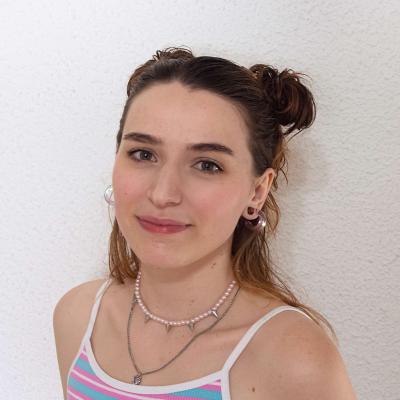At Apolline, we believe that art is much more than just techniques and skills. More specifically, we believe that the visual arts are a universal form of language that can transcend borders and ages, drawing being certainly the oldest art form ever made by human beings. Drawing expresses what we cannot say with words, it appears as if by magic after a few sketches and may never disappear. According to Paul Klee, "The role of art is to make the invisible visible". At Apolline, we take pride in helping our students discover their own artistic voice and express their inner world through their work. Our visual arts programs, including drawing, painting, manga and more, are designed to help our students develop their own artistic style while gaining the skills and confidence to express themselves openly. Whether you are a beginner or an experienced artist, our teachers are here to help you explore your creativity and realize your artistic potential. Find out more about our classes:
Apolline is an art school based in Lausanne that offers courses in drawing, painting, Manga comic book illustration, creation of books and objects, and more! Discover without further delay our courses :
Learn more
What age to draw?
There is obviously no age to start drawing! If you have young children, you have certainly already made a compilation of the most beautiful drawings made by your little one. Concerning the academic drawing at Apolline, we advise your children to wait until they are 16 years old to start the courses. Our courses require a certain maturity and a grasp of the tools of creation. Indeed, at the end of this course, you will have developed technical skills (construction of space, structure of the human anatomy, distribution of shadows and lights, dynamics of the body in movement) and will have understood the challenges of this approach. The practice of observation drawing will also lead you to a better understanding of your perceptive intelligence. Finally, it will invite you to make use of faculties that are not usually mobilized, thus fluidifying the link between body and mind.
How old to make a manga?
At Apolline, we advise your children to wait until the age of 6 to start manga classes. Our courses still require the use of creative tools. Many famous mangakas started drawing at a very young age and on the contrary, it is never too late to start. If you have a passion for art and writing, you can start learning to draw manga and tell stories now, whether you are a child, teenager or adult.
Are our classes suitable for adults?
Absolutely! Our classes are suitable for all ages, including adults. Apolline's classes include artistic activities, discoveries and initiations, suitable for adults of all levels. Whether you are a beginner or already have some experience, our classes will meet your needs and interests. The courses are designed to provide an enriching and stimulating experience for all adult learners.
What are the basics of drawing?
First of all, we need to understand what drawing is. It is an art form that allows artists to express themselves visually through shapes, colors and textures on a flat surface such as paper or a computer screen. To create accurate and expressive drawings, any beginning artist must learn and master the basics of drawing. The basics include sketching, a quick drawing technique to capture the essence of a scene or subject. Beginners can start by learning the basics of drawing such as proportion, perspective and shading before moving on to more advanced projects. Our classes cover these different stages of learning, for novices, amateurs and advanced. Moreover, learning is a continuous process for even the most experienced artists. They can always learn new techniques, new approaches and new styles to improve their work. Finally, hard work is an essential part of learning to draw. As in any field, artists must practice regularly to improve their skills and creativity.
How to find your own manga drawing style?
Finding your own style can take time and requires practice, observation and experimentation. Here are some tips to help you do so: Study the manga style: To find your own style, you must first understand the basics of drawing and the elements of style that characterize manga. Learn the basics of perspective, anatomy and composition, and study the manga drawings you admire to understand their characteristics. Experiment with different drawing styles: Try different styles of manga drawing to find the one that suits you best. Try more realistic or stylized styles, or combine different styles to create something new. Develop your own technique: By working on your work regularly, you will eventually develop your own technique and drawing style. Try to focus on what you like about your work and what makes you unique, and develop that technique. Sign up with Apolline: Finding a teacher or mentor can be very helpful in improving your drawing skills and finding your own style. You can take our classes now and/or participate in drawing workshops. Be patient and persevere: Finding your own manga drawing style can take time, so be patient and persevere. Keep drawing regularly, experiment, and eventually you will find your own unique style.
What profession if you like drawing?
If you like drawing, there are several artistic professions you could consider. First, you can become an illustrator, creating images for books, magazines, advertisements or products. You can also pursue a career as a painter, creating artwork for art galleries or collectors. To prepare for these artistic careers, you can take classes with us at Apolline for our pre-professional courses. In addition to illustration and painting, you can also consider careers in other drawing-related fields, such as video game design, animation, character design or comic book creation. Drawing skills are also useful in fields such as architecture, fashion and industrial design. All in all, if you love drawing, there are many career options in artistic and creative fields, and art schools can help you develop the skills and techniques needed to succeed.
Which technique is the most complicated in drawing?
There is no technique in drawing that is inherently more complicated than the others. It all depends on the person doing it, their skills, experience and working style. Nevertheless, some techniques may present specific challenges in terms of handling materials or mastering techniques. For example, using oil or acrylics can be more difficult due to the need to master layering, glazing and texture techniques. Charcoal can be difficult to control because of its soft, crumbly texture, while using watercolor paint may require an understanding of color transparency and opacity. Each technique has its own set of challenges, it's up to you to learn how to master them!
Training to become a comic book and manga illustrator in our school
Training in the field of manga is a dream perspective for some aspiring artists. Excellent opportunity for those who wish to discover this world and improve in this discipline. We offer a wide range of training courses for all levels, whether you are a beginner or advanced. We have weekly classes, operating on a year-round registration basis, or by week-long workshops during the vacations that we call vacation workshops. Classes are open to both boys and girls, for those who are new to the sport and want to learn the basics, as well as those who want to deepen their knowledge and improve their technique. If you are interested in learning about manga, please contact us for more information and to register. We look forward to welcoming you to our schools and helping you achieve your goals.
How do I know if my child has a talent for drawing?
It is possible to determine if your son or daughter has a talent for drawing by observing his or her behavior at school, if he or she prefers to spend time drawing rather than listening to lectures. If your child is often absorbed in his or her drawings and shows remarkable creativity, this may be a sign that visual arts are his or her forte. You can also talk to his teacher to get his opinion on your son's abilities. If your child shows a sustained interest in drawing and continues to improve despite difficulties, this may indicate a passion for art. Finally, if your child receives positive feedback on his or her drawings from classmates or family, it may suggest that he or she has a talent for drawing. Don't hesitate to encourage your child to pursue his or her interest in the visual arts by enrolling him or her in classes or by providing high-quality drawing materials to develop academic skills.
What are the differences between painting and illustration?
Painting and illustration are two visual art forms that share some similarities but also have some important differences. Here are some of the main differences: Purpose: Painting is often created to be a stand-alone work of art that is designed to be viewed in its own beauty, while illustration is created to serve a specific purpose, such as to accompany a text, story, message or communication. Medium of execution: Painting is often done on traditional media such as canvas, paper, wood or stone, while illustration can be done on a variety of media such as paper, cardboard, fabric, etc. Content: Painting can be a representation of anything that can be seen, imagined or expressed, while illustration is often related to specific content, such as a story, article, advertisement, etc. Target Audience: Painting is generally intended for a broader audience, while illustration is often intended for a more specific target audience, such as children, professionals, or enthusiasts in a specific field. In summary, the main difference between painting and illustration is their purpose and context. Painting is often created to express a personal vision, while illustration is often created to meet a specific need or to accompany a text or story.
What are the different artistic fields related to drawing?
Drawing is a very rich artistic field, which offers many possibilities of expression and creation. Among the different artistic fields related to drawing, we can mention painting, which can be done with different types of paint, such as oil, watercolor or acrylic. Painting can be used to create figurative or abstract paintings, playing with colors, textures and shapes. Drawing is also related to the graphic arts, such as comics, illustration, printmaking or screen printing. These arts allow us to tell stories, to represent characters or landscapes, using specific techniques and particular styles. Drawing can also be done with different tools, such as pencil, charcoal, pastel or pen. Each of these tools offers different possibilities of expression, playing with lines, shadows and textures. Drawing is also about observation, creation and discovery. By drawing, we can learn to observe the world around us, to capture the moment, to explore new horizons. We can also express our creativity by drawing freely, letting our imagination and emotions speak. Finally, drawing can be used to create portraits, which allow to represent the features and expressions of a person, or to play with colors, shapes and textures, using techniques such as watercolor or pastel. In short, drawing offers many possibilities of expression and creation, and allows everyone to find their own artistic path. Whatever your level or interests, the art school is here to accompany you on your artistic journey and help you develop your creativity.
What exactly is Manga?
Manga is a genre of comics originating in Japan that has gained popularity worldwide. The word "manga" literally means "comic book" in Japanese, but it is often used to describe a specific style of illustration that has become synonymous with Japanese comics. The manga art form is characterized by expressive facial features, exaggerated characters and exciting stories that span many genres, such as science fiction, fantasy, romance and comedy. A mangaka, or manga writer, is an artist who creates manga. He is often very talented and passionate about his work. The mangaka is often a real star in Japan. Manga has become an important part of Japanese culture and is very popular with Japanese people of all ages. Although manga originated in Japan, it is now appreciated all over the world and has influenced many artists and comic book writers around the globe.
Manga, an intergenerational world?
One of the most famous events in France for manga and pop-culture fans is the Japan Expo, which is held every year in Paris. This fair is an opportunity for fans to meet artists, publishers, authors, cosplayers, and to participate in workshops and conferences. A father recently told us about his experience: he took his two children, a son and a daughter, to the Japan Expo, and all three came back delighted. Before this visit, the son was a circus performer and the daughter was passionate about theater. They were both training in the canton of Geneva in Veyrier. Since the Japan Expo, they discovered a fascinating universe and changed their way of life. The son started drawing manga, while the daughter started cosplay. As for the father, he discovered One Piece and fell in love with the story. "I am delighted to have found a passion to share with them, also fans of One Piece. It is a universe that brings us together and allows us to spend unforgettable moments together," he said. So the manga has an intergenerational dimension, which allows members of the same family to share a common passion, not bad no ;).
Should manga drawing be taught as part of the school curriculum?
Teaching manga drawing can be beneficial for students, but it depends on the school context. If a school wants to integrate the teaching of manga drawing into its curriculum, it could be an opportunity for students to develop their creativity and visual communication skills. However, it is important that the teachers who teach manga drawing are qualified to do so, and that they have the appropriate training and experience to teach this technique. It is also important that this specific teaching is not considered a substitute for teaching the fundamentals of drawing. Students need to learn the basic techniques before they can explore more specific styles. In addition, it is important that students understand that manga drawing is an art form specific to Japanese culture, and that it should not be used as a universal representation of visual art. If manga drawing instruction is added to the school curriculum, it could be offered as an additional training or workshop, rather than a required course. It could be offered to interested students as part of a club or a special week of training for the visual arts. Ultimately, the decision to incorporate manga drawing instruction into the school curriculum depends on the school's educational goals and its ability to provide adequate training. Otherwise, you enroll your child with us!
What tips do you have for learning how to draw manga?
Manga drawing is a fascinating art that requires patience, creativity and lots of practice. Whether you are a beginner or have some drawing experience, there are several useful tips for learning to draw manga. First, it's important to learn the basics of drawing, including perspective, anatomy, composition and shading. This will allow you to create more realistic and consistent manga drawings. If you don't know these basics yet, no worries, our classes will guide you to these first skills. Then, it is important to study the multiple facets of manga drawing such as contour lines, shading effects and facial expressions. Take inspiration from the works you like to create the effects you want. This will give you a deeper understanding of how manga drawings are created. Another useful tip for learning how to draw manga is to practice regularly. Try to draw every day, even if it's just for a few minutes. The more you practice, the better you will become at drawing manga. It can also be helpful to draw from models, whether they are photos or even videos. This will help you develop your understanding of anatomy and hone your drawing skills.
What is a Storyboard?
When you have an idea, it is sometimes not so easy to turn it into a comic strip, a cartoon or a movie. To do this, before launching into the final result, we can go through several stages that allow us to gradually specify what we would like to do. For example, if I have the idea of a sheep that skis, I need to have a sheep, skis and a camera to make a film or paper and pencil to make a comic strip. But it's useful to go through a drawing first, a sketch. Well, the storyboard is, in a way, the sketch of the comic strip or the film. It consists of drawings and sentences, placed side by side. "Story" means "story" and "board" means "guidance". The storyboard is a dashboard, a guide. So the producers, actors and production workers of the film have an overview before shooting, the designers have an idea of what it might look like, what problems they might encounter, what is worth drawing, before they go to the final board.
Is it possible to follow the courses online?
Unfortunately, it is not possible to follow our illustration courses online or via webcam. Since the classes are in groups, attendance is essential to the progress and smooth running of the class. The children exchange with their teacher who immediately corrects them. Giving the lessons online, in this context, is therefore of no interest.
Are there any workshops/courses/holiday camps at Apolline's?
Yes, we do! Visit our website to discover our vacation camps, workshops and courses. Based in several cities in the French part of Switzerland, Apolline offers comic book/manga drawing courses during the school vacations in your canton. This is not a vacation camp as such, as the children do not sleep on site. The activity focuses on 3 hours of intensive classes per day from Monday to Friday. The courses can be taken in the morning from 9am to 12pm, or in the afternoon from 1:30pm to 4:30pm. Cities where we organize our drawing courses : Geneva - Etoy - Lausanne - Montreux - Yverdon - Sion - Neuchâtel - Delémont - Fribourg - Bienne
Are the courses only held in Lausanne?
Concerning the academic drawing courses given by our teacher Christian, they do take place in Lausanne and not in other cities of French-speaking Switzerland like Geneva or Montreux. You can consult our website to discover all the cities in which we carry out our activities.
Prices
| Classes | Duration | Monthly price* | Annual price** |
| Visual art class for 6 to 10 year-olds | 60 minutes |
79.00 CHF |
900.00 CHF |
| Visual art class for 8 to 13 and 10 to 16 year-olds | 90 minutes |
99.00 CHF |
1'150.00 CHF |
| Adult or advanced visual art class | 120 minutes | 129.00 CHF | 1'490.00 CHF |
* 12 monthly payments to be paid from September to August (see our rules).
** Price for the payment of the whole year's courses in one installment.
Valid for an annual registration (courses from September to June). All fees are included in the prices shown. Registration during the year is possible (price calculated in proportion to the number of remaining courses)






